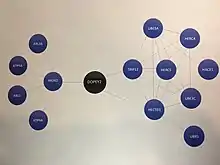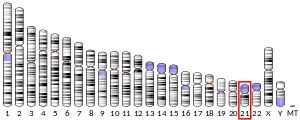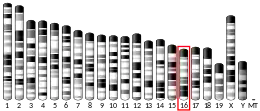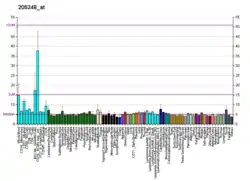DOP1B
DOP1B is a human gene located just above the Down Syndrome chromosomal region (DSCR) located at 21p22.2 sub-band.[5][6][7] Although the exact function of this gene is not yet fully understood, it has been proven to play a role in multiple biological processes, and its over-expression (triplication) has been linked to multiple facets of the Down Syndrome phenotype, most notably mental retardation.[6]
| DOP1B | |||||||||||||||||||||||||||||||||||||||||||||||||||
|---|---|---|---|---|---|---|---|---|---|---|---|---|---|---|---|---|---|---|---|---|---|---|---|---|---|---|---|---|---|---|---|---|---|---|---|---|---|---|---|---|---|---|---|---|---|---|---|---|---|---|---|
| Identifiers | |||||||||||||||||||||||||||||||||||||||||||||||||||
| Aliases | DOP1B, 21orf5, C21orf5, dopey family member 2, DOPEY2, DOP1 leucine zipper like protein B | ||||||||||||||||||||||||||||||||||||||||||||||||||
| External IDs | OMIM: 604803 MGI: 1917278 HomoloGene: 21068 GeneCards: DOP1B | ||||||||||||||||||||||||||||||||||||||||||||||||||
| |||||||||||||||||||||||||||||||||||||||||||||||||||
| |||||||||||||||||||||||||||||||||||||||||||||||||||
| |||||||||||||||||||||||||||||||||||||||||||||||||||
| |||||||||||||||||||||||||||||||||||||||||||||||||||
| |||||||||||||||||||||||||||||||||||||||||||||||||||
| Wikidata | |||||||||||||||||||||||||||||||||||||||||||||||||||
| |||||||||||||||||||||||||||||||||||||||||||||||||||
Gene
The DOP1B gene is located on human chromosome 21, at chromosome band 21q22.12.[5] This band is located in open reading frame 5, hence the alias C21orf5. DOP1B gene is composed of 137,493 bases making up 37 exons and 39 distinct gt-ag introns, all located between CBR3 and KIAA0136 genes.[6][8]
Transcription produces 10 unique mRNAs, 8 alternatively spliced variants, and 2 unspliced forms.[8] These unique mRNAs differ by varying truncation of the 3' and 5' ends, as well as the presence of 3 cassette exons.[8] These mRNA variants range from 7691bp (mRNA variant DOPEY2.aAug10) to 315bp (mRNA variant DOPEY2.jAug10-unspliced) and are further described in Table 1 below.[9]
The mRNA expressed and levels of expression differ based on the location and tissue type in the body, but overall has been found to be expressed ubiquitously.[6] The highest expression has been found in differentiating, rather than proliferating, tissue zones.[5] Transcript was identified with the highest confidence in the erythroleukemia, placental cells and overall in the brain, and at a medium confidence level in the perirhinal cortex, medial temporal lobe, colon, as well in the salivary and adrenal glands.[8]
Protein
Of the ten mRNAs produced, six of them are translated into viable proteins. Please see table above for more details.[9] The largest, having a molecular weight of 258230 Da, and highest expressed protein, DOP1B.a, is composed of 2298 amino acids that make up an N-terminal domain, seven transmembrane domains, and a C-terminal coiled coil stretch that forms a leucine-like zipper domain.[8] Like other leucine zippers domains, DOP1B's C-terminal is hypothesized to be involved in multiple protein-protein and transcription factor interactions.[6] This indicates that DOP1B might act as a transcription co-activator; however, further research must be done to fully understand the precise physiological function.[6]
Protein Interactions
Very little work has been done on understanding the intricacies of the protein interactions; however, STRING has identified direct links with three proteins: MON2, TRIP12, and HECTD1.[10] DOP1B is also indirectly associated with the following proteins: ARL16, ATP9A, ARL1, ATP9B, UBE3A, HERC5, HERC4, HACE1, UBE3C, and UBR5.[10] See Figure 2 for interactions.

Homology
Phylogenesis suggest that DOP1B can be traced back to a common ancestor of animals and fungi due to its highly conserved C-terminal domain DOP1B has 84 known orthologs and 158 speciation nodes in the gene tree.[11] The most similar orthologs being in the chimpanzee (Pan troglodytes), dog (Canis familiaris), cow (Bos Taurus), as well as the rat and mouse (Rattus norvegicus and Mus musculus).[11]
Sub-cellular localization
Gene Ontology (GO) has traced the DOP1B protein to 5 main areas: the Golgi membrane, the trans-Golgi network, cytosol, and extracellular endosome.[8] COMPARTMENTS localization data places the highest confidence of localization to the extracellular exosome and the Golgi membrane.[12]
Figure 1: Description of mRNA and Protein Variants:[9]
| mRNA
Variant |
Spliced mRNA Length | Protein Length | 5' UTR | 3' UTR | Unspliced pre-mRNA Length | Number of Exons | Tissue-mRNA Expression (no strict specificity implied) |
|---|---|---|---|---|---|---|---|
| aAug10 | 7691 bp | 2298 aa | 85 bp | 709 bp | 129746 bp | 37 | ubiquitous |
| bAug10 | 2173 bp | 332aa | 1174 bp | 15610 bp | 6 | carcinoid, lung, colon, colon tumor, RER+ | |
| cAug10 | 742 bp | 222 aa | 74 bp | 49789 bp | 6 | breast, t-lymphocytes | |
| dAug10 | 623 bp | 145 aa | 188 bp | 43664 bp | 4 | lung | |
| eAug10 | 345 bp | 114 aa | 9925 bp | 3 | spleen | ||
| fAug10 | 571 bp | 110 aa | 241 bp | 1322 bp | 2 | thalamus | |
| gAug10 | 549 bp | non-coding | 11 bp | 499 bp | 794 bp | 2 | spleen |
| hAug- unspliced | 543 bp | non-coding | 377 bp | 543 bp | 1 | stomach | |
| iAug10 | 514 bp | non-coding | 205 bp | 204 bp | 7377 bp | 2 | thyroid gland |
| jAug10-
unspliced |
315 bp | non-coding | 165 bp | 315 bp | 1 | marrow |
Function
As mentioned previously, the specific function and however, its function can be largely inferred through the study of similar genes. DOP1B has been found to be involved in the following processes: multicellular organism development in cell differentiation and developmental patterning, cognition, as well as endoplasmic reticulum organization and Golgi to endosome transport.[5][6][13][14]
Cell differentiation and patterning
The DOP1B ortholog, pad-1, in C. elegans, was found to have a role in cell differentiation and patterning. In an experiment where the pad-1 was silenced using RNA-mediated interference, the phenotype of the injected worm's offspring was fetal lethality.[5] The reason being: most of the embryonic tissues did not undergo appropriate cell patterning during gastrulation.[5] Abnormally positioned cells lead to misinformation of organs; the failed morphogenesis of embryo.[5] A similar observation was made in the inactivation of the Dop1 gene, the DOP1B ortholog, in S. cerevisiae.[6] The inactivation lead to abnormal cell positioning and subsequent death. Overexpression of the N-terminal in S. cerevisiae also resulted in a loss of proper growth polarity and abnormal asexual reproductive patterning.[6] This function was further supported by the function of the ortholog DopA in A. nidulans, which similarly codes for a 207kDa protein that also contains leucine zipper-like domains.[15] Its inactivation revealed its role directing alternations in cell division timing, growth polarity, as well as cell-specific gene expression, ultimately affecting organogenesis and cell differentiation.[15]
Endoplasmic reticulum and golgi transport
Dop1, an ortholog of DOP1B, in S. cerevisiae was found to play an essential role in membrane organization.[13] It was found that it forms a complex with another protein, Mon2, which recruits the pool of Dop1 from the Golgi.[13] In a Mon2 knockout model, Dop1 was mislocalized, and in turn resulted in defective cycling between endosomes and the Golgi.[13] In a Dop1 knockout model, severe defects in the endoplasmic reticulum organization.[13] This Dop1 and Mon2 complex was also linked to traffic in the enocytic pathway.[13]
Clinical significance
Cognition
DOP1B has been identified as a CNV region in Alzheimer's disease subjects, and its triplication has been tied to various phenotypic aspects of Down Syndrome.[14]
Down syndrome
DOP1B has been associated with the Down Syndrome phenotype.[6] When DOP1B was overexpressed in mice, abnormal lamination patterns of cortical cells was observed, as well as altered cortical, hippocampal, and cerebellar cells, regions that play key roles in memory and learning.[6] These changes are similar to those observed in Down Syndrome patients.[6] It is because of this that C21orf15 is now being studied as a new candidate gene for the intellectual disability phenotype in Down Syndrome.[6]
See also
References
- GRCh38: Ensembl release 89: ENSG00000142197 - Ensembl, May 2017
- GRCm38: Ensembl release 89: ENSMUSG00000022946 - Ensembl, May 2017
- "Human PubMed Reference:". National Center for Biotechnology Information, U.S. National Library of Medicine.
- "Mouse PubMed Reference:". National Center for Biotechnology Information, U.S. National Library of Medicine.
- Guipponi M, Brunschwig K, Chamoun Z, Scott HS, Shibuya K, Kudoh J, Delezoide AL, El Samadi S, Chettouh Z, Rossier C, Shimizu N, Mueller F, Delabar JM, Antonarakis SE (August 2000). "C21orf5, a novel human chromosome 21 gene, has a Caenorhabditis elegans ortholog (pad-1) required for embryonic patterning". Genomics. 68 (1): 30–40. doi:10.1006/geno.2000.6250. PMID 10950924.
- Rachidi M, Lopes C, Costantine M, Delabar JM (2005-01-01). "C21orf5, a new member of Dopey family involved in morphogenesis, could participate in neurological alterations and mental retardation in Down syndrome". DNA Research. 12 (3): 203–10. doi:10.1093/dnares/dsi004. PMID 16303751.
- Shapiro BL (1999). "The Down syndrome critical region". Journal of Neural Transmission. Supplementum. 57: 41–60. doi:10.1007/978-3-7091-6380-1_3. ISBN 978-3-211-83377-3. PMID 10666667.
- Consortium, Gene Ontology. "AmiGO 2: Term Details for "molecular_function" (GO:0003674)". amigo.geneontology.org. Retrieved 2017-11-29.
- Thierry-Mieg D, Thierry-Mieg J. "AceView: Gene:DOPEY2, a comprehensive annotation of human, mouse and worm genes with mRNAs or ESTsAceView". www.ncbi.nlm.nih.gov. NCBI/NLM/NIH. Retrieved 2017-11-30.
- "26 items (Homo sapiens) - STRING network view". string-db.org. Retrieved 2017-11-29.
- "Gene: DOPEY2 (ENSG00000142197) - Gene tree - Homo sapiens - Ensembl genome browser 90". www.ensembl.org. Retrieved 2017-11-29.
- "COMPARTMENTS - DOPEY2". compartments.jensenlab.org. Retrieved 2017-11-30.
- Gillingham AK, Whyte JR, Panic B, Munro S (January 2006). "Mon2, a relative of large Arf exchange factors, recruits Dop1 to the Golgi apparatus". The Journal of Biological Chemistry. 281 (4): 2273–80. doi:10.1074/jbc.M510176200. PMID 16301316.
- Swaminathan S, Huentelman MJ, Corneveaux JJ, Myers AJ, Faber KM, Foroud T, Mayeux R, Shen L, Kim S, Turk M, Hardy J, Reiman EM, Saykin AJ (2012). "Analysis of copy number variation in Alzheimer's disease in a cohort of clinically characterized and neuropathologically verified individuals". PLOS ONE. 7 (12): e50640. Bibcode:2012PLoSO...750640S. doi:10.1371/journal.pone.0050640. PMC 3515604. PMID 23227193.
- Pascon RC, Miller BL (June 2000). "Morphogenesis in Aspergillus nidulans requires Dopey (DopA), a member of a novel family of leucine zipper-like proteins conserved from yeast to humans". Molecular Microbiology. 36 (6): 1250–64. doi:10.1046/j.1365-2958.2000.01950.x. PMID 10931277. S2CID 27402390.
Further reading
- Nakajima D, Okazaki N, Yamakawa H, Kikuno R, Ohara O, Nagase T (June 2002). "Construction of expression-ready cDNA clones for KIAA genes: manual curation of 330 KIAA cDNA clones". DNA Research. 9 (3): 99–106. CiteSeerX 10.1.1.500.923. doi:10.1093/dnares/9.3.99. PMID 12168954.
- Dahmane N, Ghezala GA, Gosset P, Chamoun Z, Dufresne-Zacharia MC, Lopes C, Rabatel N, Gassanova-Maugenre S, Chettouh Z, Abramowski V, Fayet E, Yaspo ML, Korn B, Blouin JL, Lehrach H, Poutska A, Antonarakis SE, Sinet PM, Créau N, Delabar JM (February 1998). "Transcriptional map of the 2.5-Mb CBR-ERG region of chromosome 21 involved in Down syndrome". Genomics. 48 (1): 12–23. doi:10.1006/geno.1997.5146. PMID 9503011.
- Nagase T, Ishikawa K, Suyama M, Kikuno R, Hirosawa M, Miyajima N, Tanaka A, Kotani H, Nomura N, Ohara O (February 1999). "Prediction of the coding sequences of unidentified human genes. XIII. The complete sequences of 100 new cDNA clones from brain which code for large proteins in vitro". DNA Research. 6 (1): 63–70. doi:10.1093/dnares/6.1.63. PMID 10231032.
- Guipponi M, Brunschwig K, Chamoun Z, Scott HS, Shibuya K, Kudoh J, Delezoide AL, El Samadi S, Chettouh Z, Rossier C, Shimizu N, Mueller F, Delabar JM, Antonarakis SE (August 2000). "C21orf5, a novel human chromosome 21 gene, has a Caenorhabditis elegans ortholog (pad-1) required for embryonic patterning". Genomics. 68 (1): 30–40. doi:10.1006/geno.2000.6250. PMID 10950924.
- Lopes C, Chettouh Z, Delabar JM, Rachidi M (June 2003). "The differentially expressed C21orf5 gene in the medial temporal-lobe system could play a role in mental retardation in Down syndrome and transgenic mice". Biochemical and Biophysical Research Communications. 305 (4): 915–24. doi:10.1016/S0006-291X(03)00867-2. PMID 12767918.
- Rachidi M, Lopes C, Delezoide AL, Delabar JM (2006). "C21orf5, a human candidate gene for brain abnormalities and mental retardation in Down syndrome". Cytogenetic and Genome Research. 112 (1–2): 16–22. doi:10.1159/000087509. PMID 16276086. S2CID 22696699.




